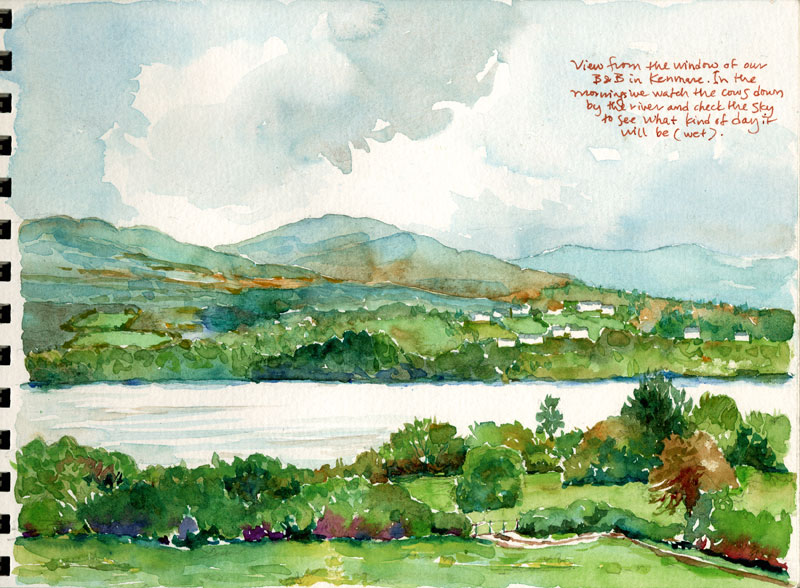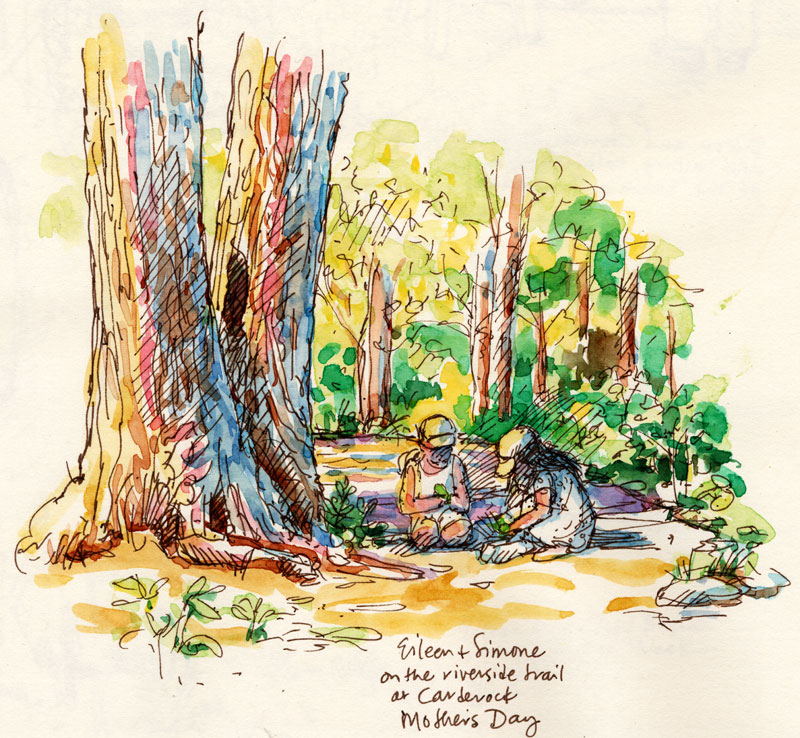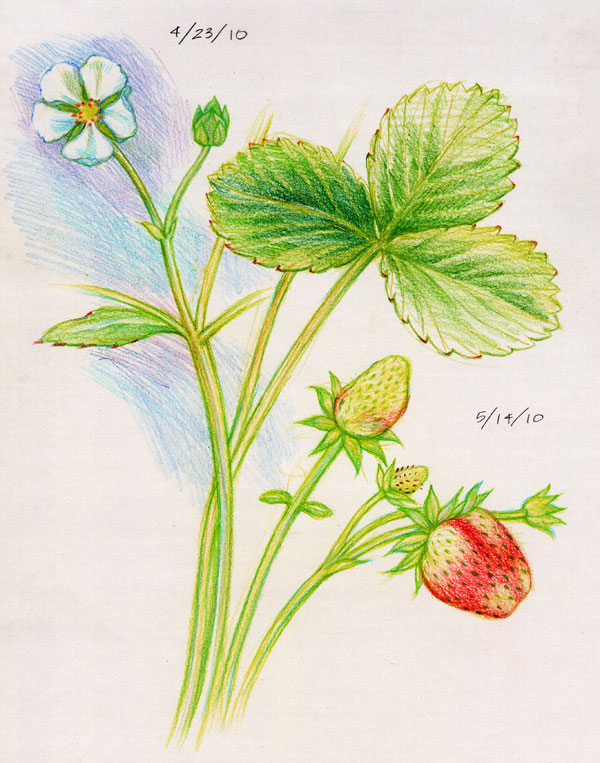Here is friend and neighbor Tom, a brainy and funny guy who combines 21st century thinking with old-fashioned gentlemanly kindness. In honor of his birthday I am putting up this drawing of him from my sketchbook. Although it was drawn several years ago, Tom never seems to get any older. (What’s REALLY in that glass, anyway?) Happy Birthday, Tom. Perhaps you are already awake and having your morning Elixir of Youth.
Month: May 2010
Not Again
Eatin’ on the Beat
Crazy for Math
This is a page of the Improper Fractions lesson from our homeschooling Fractions block. I hope to get the entire book up on the Homeschooling page eventually. For now it serves as an introduction for what I am about to tell you.
Recently a big group of us had dinner at the home of our friends Lynn and Giovanni. The meal ended with everyone playing with math puzzles and games around the dining room table. Lynn, a Math Whiz, owns hundreds of them. For years she was a math instructor and tutor. Then in 1999 she developed a summer Math Camp called “MathTree.” It’s not only for kids struggling with math, but also for kids who can’t get enough and want it included in their summers. (I understand that there actually ARE such children, although none has shown up in my family.)
MathTree has taken off—that first summer there were two locations, and now there are 26 of them (!!!), for kids ages five to teens, all over the Washington metropolitan area. Lynn has developed a hands-on approach using objects, games, puzzles, and real-life experiences. (I was reading the fliers for the camp choices and thinking I might like to sign up myself! except they don’t have my age group.) If you are looking for an unusual kids’ math camp, MathTree might be just the ticket. So I’m putting a link to the website and brochure here. As my husband and I frequently remind each other, Someday Our Children Will Thank Us.
Library of Congress-Part 3
(If this picture is baffling, please see the news story on the Texas school board’s decision to eliminate Thomas Jefferson from its textbooks.)
Continued from Library of Congress–Part 2, May 7th
Spofford proposed a separate building for a library that would equal (or surpass! he suggested temptingly to Congress) the great libraries of Europe. It took about 15 years to hold a design competition and authorize funds, but at last, between 1886 and 1897, an astonishing team of architects, engineers, artists, and craftspeople created the Thomas Jefferson Building, probably the most magnificent structure in Washington, DC, and certainly the most labor-intensive per square inch.
The award-winning design was a building in the style of the Italian Renaissance, “efficient, beautiful, and safe,” and its thoughtful embellishment and finishing—despite a hovering Congress with its eye on the budget—is a suitable tribute to that period of cultural flowering. Stroll through and marvel at the multi-layered ornamentation, in paint, marble, and mosaic, depicting images and figures historical and mythological honoring the higher achievements of humanity: philosophy, natural science, music, art, theology, astronomy, law.
And these many wonders house a collection even more wondrous. Who could have foreseen, on that day in 1800 when John Adams signed the appropriations bill, what would develop from an initial purchase of 740 books and three maps? This is from the Library’s own website:
The Library of Congress is the largest library in the world, with nearly 145 million items on approximately 745 miles of bookshelves. The collections include more than 33 million books and other print materials, 3 million recordings, 12.5 million photographs, 5.3 million maps, 6 million pieces of sheet music and 63 million manuscripts… The Library receives some 22,000 items each working day and adds approximately 10,000 items to the collections daily… In 1992 it acquired its 100 millionth item.
Not only that, but at the Library you will find:
Works in 470 languages. Four Hundred and Seventy.
Newspapers in many of those languages, from all over the world.
Over 5,000 books printed BEFORE 1500, including a Gutenberg Bible.
Library Service for the Blind and Physically Handicapped, with Talking Books and other resources available free of charge.
The Center for the Book, created to promote literacy and reading, with affiliates in all 50 states.
The American Folklife Center, with 4,000 collections of stories, music, and oral history.
An ongoing program of lectures, symposia, exhibitions, concerts, book-signings, films, and tours both general and specific.
The Library of Congress also sponsors the popular annual National Book Festival on the Mall, bringing authors and readers together for readings and discussion.
Whew! And that’s not even all….for the rest of it you must go to the website to discover. Or to the Library itself.
The Library of Congress remains a work in progress, an almost unimaginable organizational, classification, conservation and retrieval challenge. Its evolution from modest beginnings is astounding. It has survived fires, civil and world wars, recessions and depressions, and an international information explosion.
And you, dear Reader, should you manage to make it to Washington, DC, and if you are at least 16 years of age (high school students must show that they have first exhausted their other sources for research) and have a valid identification card, such as a driver’s license: YOU are eligible for a Library of Congress Reader Identification card, and you may pursue your studies, with access to hundreds of years of accumulated knowledge and beauty, in the splendid Reading Room of this marvelous, this amazing, this thank-your-lucky-stars national treasure.
Irish Skies are Smiling
My husband has a widget on his desktop with which he tracks the weather in his favorite places. Orcas Island, in Washington state. Montpelier, Vermont. Paris, France. And Dublin, Ireland, where for the last couple of weeks it’s been sunny, with a high in the low 70s.
The weather we experienced in Ireland was more like this (above). Beautiful, but “soft.” As they say, there is no bad weather; only the wrong clothes.
Sugarloaf Mountain hike
This sketch is from a Mothers Day hike at Carderock a couple of years ago, and I’m posting it as an excuse to tell you Washingtonians about another hike entirely, on Saturday, May 22nd, sponsored by the Audubon Naturalist Society. Melanie Choukas-Bradley and Tina Brown (respectively, author and illustrator of Sugarloaf: The Mountain’s History, Geology and Natural Lore) will lead a hike at Sugarloaf Mountain while simultaneously discussing the botany, wildlife, geology, and history of the area. (They must have better lungs than I do!) At the lunch break, Tina Brown will give a nature-sketching demonstration, so carry your sketchbooks.
Some of you may have attended Melanie Choukas-Bradley’s wonderful Earth Day talk about the botanical highlights of the Washington area, which was entertainingly intertwined with local history and biography. If you didn’t make it to the talk, you can look for her book, City of Trees. (It’s not often I can find three of my favorite subjects in ONE book.)
You can find more details about the hike at the Audubon website.
Strawberries
Three years ago my daughter and I bought three little strawberry plants at a school fair. Each year they have multiplied, and now we have about fifteen pots full of plants on our tiny rooftop deck. This spring we are drawing them at their different stages of development for our Botany block, and the process, from bud to fruit, is pretty fascinating. The strawberries are terrific. Unfortunately this year a squirrel has discovered them and visits often. What’s so annoying is that he (she?) doesn’t simply eat an entire strawberry, but takes large bites out of several and then wanders off. One day I caught him trying to BURY one as if it were a nut.
Ireland Sketchbook
Thanks to my tech-savvy son, my Ireland sketchbook is now up on my website. This is the first page, and you can look at the rest here. I hope it will be followed by other sketchbooks soon.
















